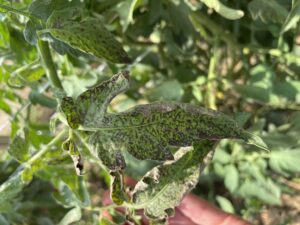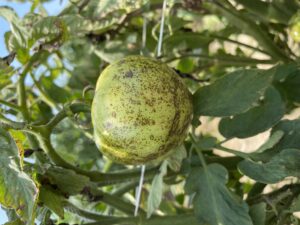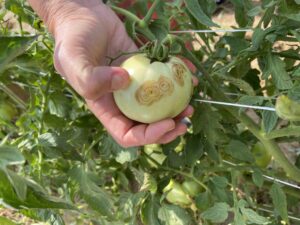Resistance-breaking variants of TSWV found on Tomato in NC
go.ncsu.edu/readext?906970
en Español / em Português
El inglés es el idioma de control de esta página. En la medida en que haya algún conflicto entre la traducción al inglés y la traducción, el inglés prevalece.
Al hacer clic en el enlace de traducción se activa un servicio de traducción gratuito para convertir la página al español. Al igual que con cualquier traducción por Internet, la conversión no es sensible al contexto y puede que no traduzca el texto en su significado original. NC State Extension no garantiza la exactitud del texto traducido. Por favor, tenga en cuenta que algunas aplicaciones y/o servicios pueden no funcionar como se espera cuando se traducen.
Português
Inglês é o idioma de controle desta página. Na medida que haja algum conflito entre o texto original em Inglês e a tradução, o Inglês prevalece.
Ao clicar no link de tradução, um serviço gratuito de tradução será ativado para converter a página para o Português. Como em qualquer tradução pela internet, a conversão não é sensivel ao contexto e pode não ocorrer a tradução para o significado orginal. O serviço de Extensão da Carolina do Norte (NC State Extension) não garante a exatidão do texto traduzido. Por favor, observe que algumas funções ou serviços podem não funcionar como esperado após a tradução.
English
English is the controlling language of this page. To the extent there is any conflict between the English text and the translation, English controls.
Clicking on the translation link activates a free translation service to convert the page to Spanish. As with any Internet translation, the conversion is not context-sensitive and may not translate the text to its original meaning. NC State Extension does not guarantee the accuracy of the translated text. Please note that some applications and/or services may not function as expected when translated.
Collapse ▲In summer 2022, symptoms of TSWV (Tomato spotted wilt virus) were observed at two tomato farms in Rowan County, NC on several fresh market tomato cultivars with the gene for TSWV resistance (Sw-5). Approximately 10% of plants of ‘Red Mountain’ had symptomatic foliage on one farm with approximately 30% of fruit showing symptoms. At the second farm, up to 50% of plants had symptomatic foliage with approximately 80% of fruit showing symptoms on ‘Mountain Gem’. Visual symptoms included stunting, severe leaf curling and bronzing, necrotic lesions on leaves, petioles and stems, and concentric ring spots on fruit. TSWV ImmunoStrips from Agdia confirmed the virus was present in the field. Samples were collected from both farms and subjected to sequencing to identify and confirm the presence of resistance-breaking strains.
The resulting partial sequences of the virus from the first farm were confirmed to have the mutation that results in overcoming resistance to the Sw-5 gene, as reported in CA in 2016. The sequences from the second farm had a different and novel mutation that was found to also overcome the Sw-5 gene and were different from the variant from the first farm. Therefore, two resistance-breaking variants of TSWV have been confirmed on tomato in North Carolina.
This discovery resulted from a collaboration of growers and scientists. The growers mentioned above initially alerted Dr. Reza Shekasteband, Research Scholar and Associate Tomato Breeder in Horticultural Science at NC State, who was evaluating TSWV on breeding lines and commercial cultivars with Sw-5 on their farms. When TSWV symptoms were observed on resistant cultivars, he alerted NC State plant pathologists, Dr. Dorith Rotenberg, Kirsten Lahre, Inga Meadows, and Dr. Anna Whitfield to verify that this was indeed a a resistance-breaking variant of TSWV. This new discovery and rapid characterization of the new TSWV variant highlight the strong collaborations between NC vegetable growers and scientists from different disciplines and the importance of on-farm research and trials.
Growers and stakeholders are strongly advised to monitor their tomato seedlings and plants for symptoms of TSWV. If you suspect TSWV is occurring on a tomato variety that is resistant, contact your local extension agent and submit samples through the NC State Plant Disease and Insect Clinic. Keep in mind that resistant varieties may still exhibit symptoms on fruit when thrips and virus populations are high because the gene is not expressed in flowers.
Tomato spotted wilt virus is primarily transmitted by the western flower thrips. Symptoms include those described above and pictures in this factsheet. Management relies on an integrated approach including deployment of resistant varieties, rotation of insecticides, and reducing weed populations around greenhouses and fields which can harbor the virus. Identifying resistance-breaking variants of TSWV reduces our management tools and threatens the tomato industry in North Carolina.
See this disease factsheet for more information.
This article was prepared by Dr. Dorith Rotenberg, Dr. Anna Whitfield and Inga Meadows.





